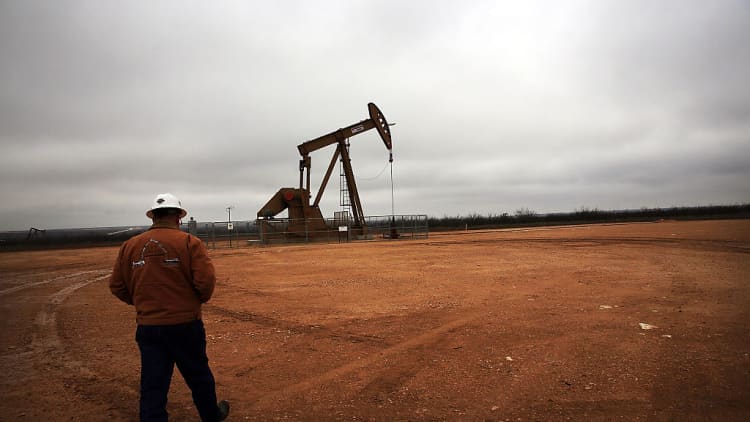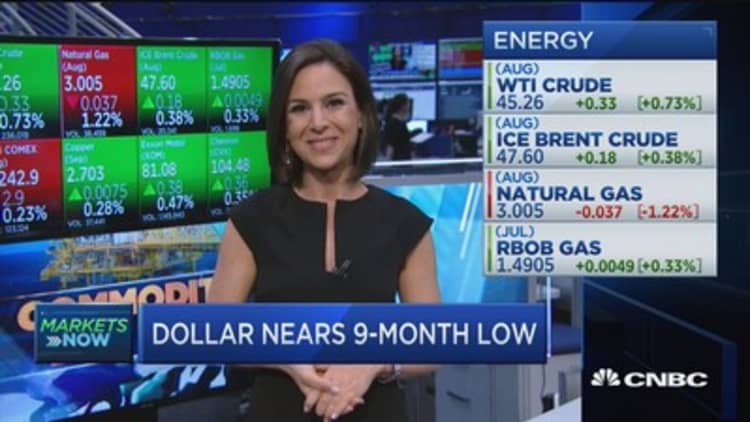
OPEC has lost its grip on the oil market, but crude prices will likely set a bottom in the low $40s per barrel, according to the latest CNBC Oil Survey.
Sixty percent of participants agree that OPEC has lost control of the oil market, and the same percent also expect the cartel to continue its efforts to "jawbone" or talk up prices.
Just over half — or 53 percent of the participants in CNBC's latest survey — say the bottom for oil prices is likely to be in the low $40s per barrel. However, 70 percent would not rule out a further drop into the $30s. Forty-six percent see it holding in the high $30s if it does go below $40 per barrel.
Forty-seven percent of the 15 oil market experts say there is more downside risk, but 40 percent say there should not be. Oil prices are expected to end the year between $40 and $49 per barrel, according to 47 percent, while 33 percent see prices in the $50 to $59 per barrel range.
Oil prices rose for an eighth day Monday, in the longest winning streak in more than five years. West Texas Intermediate crude futures settled up 2.2 percent at a one-month high, $47.07 per barrel.
WTI hit a recent low of $42.05 per barrel on June 21, a level it had been near in November. The low in August 2016 was $39.19 per barrel. Oil rose as U.S. government data on drilling activity for new oil production in the United States fell for the first time since January, dropping by two rigs. Monthly government data also showed crude output fell in April for the first time this year.
U.S. Energy Information Administration figures, released Friday, showed that U.S. output fell by 24,000 barrels per day on a monthly basis, a bullish signal for the market.

Oversupply was cited by 93 percent in the survey, as the biggest factor influencing prices right now, and 80 percent expect it to be the biggest factor for the remainder of the year. Just 7 percent see demand as the biggest issue. Seven percent see geopolitical threats as a bigger factor affecting prices, and 6 percent expect OPEC will be the greatest influence in the second half of the year.
Forty-seven percent believe demand is stronger but 40 percent believe it is flat. Thirteen percent say demand is trending weaker.
Commodities analyst Dennis Gartman, publisher of the Gartman Letter, says that the world must understand that the hydraulic fracturing and horizontal drilling technologies used by U.S. drillers have not even begun to be used in other parts of the world.
"It WILL, the effects of which are obviously long term very, very bearish," he wrote in comments supplied with survey results. Gartman said U.S. technology will expand to Russia, Mexico, China the Middle East and Africa.
"The Deputy Crown Prince of Saudi Arabia knows these things as well as anyone and it is his intention to sell his country's oil reserves as quickly as he is able to secure what 'wealth' he can before crude oil at some point in the next two or three generations falls to near zero and is used only as a source of product production and not as a fuel for internal engines. He 'gets' it; few others around him do," Garman wrote.
Mohammed bin Salman, now crown prince, has been promoting a program to diversify Saudi Arabia away from its dependence on crude. As part of the plan, the kingdom hopes to take its state-owned oil giant, Saudi Aramco, public. Analysts say that is one reason Saudi Arabia is willing to keep to an agreement to cut production, hoping it will help stabilize the market and boost prices.
The increase in production by U.S. shale drillers, or frackers, has been a key issue for the market, with U.S. output at about 9.3 million barrels per day. According to the CNBC survey, 60 percent say President Donald Trump's pro-energy policies have had no effect on prices, but 33 percent say they have hurt prices a little and 7 percent see a large negative impact.
"If frackers continue to push to 10 million barrels per day — oil will be in the low $30s by the winter," wrote Anthony Grisanti of GRZ Energy.
Watch: Why crude is headed to $55



